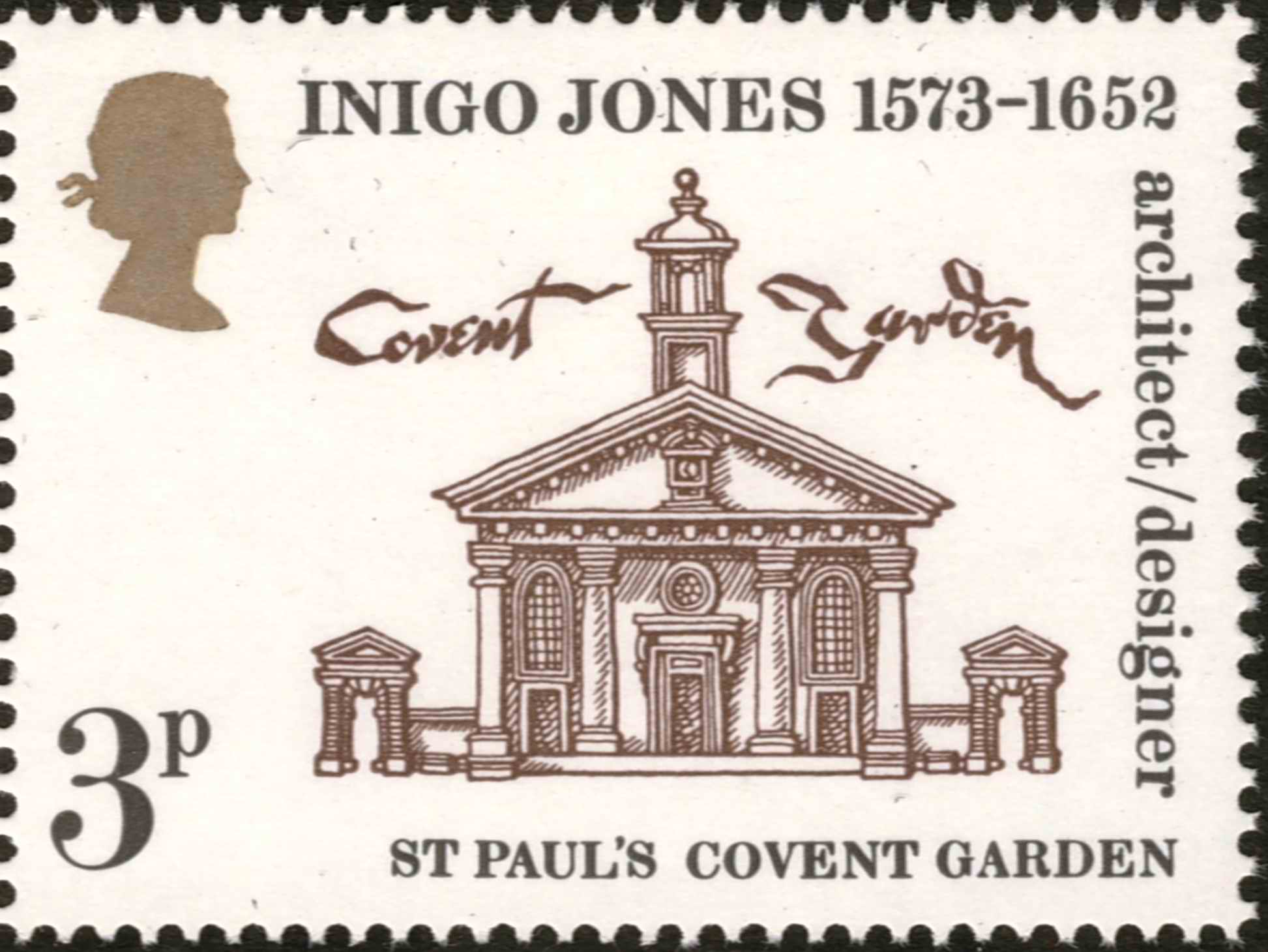A fully illustrated version of this walk, that's easy to print, is available as a PDF file by
clicking here
Jump to second part of walk by clicking here
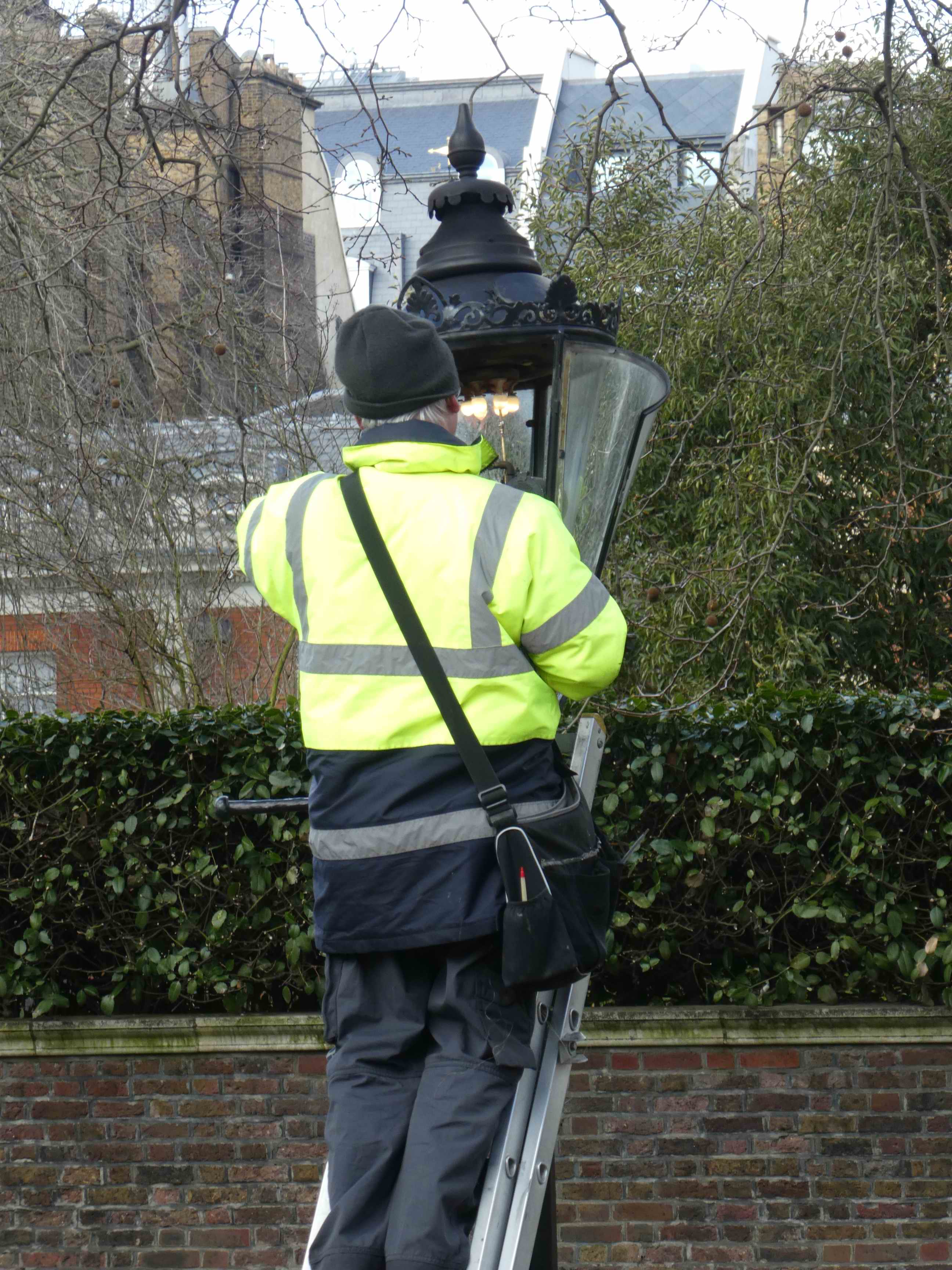
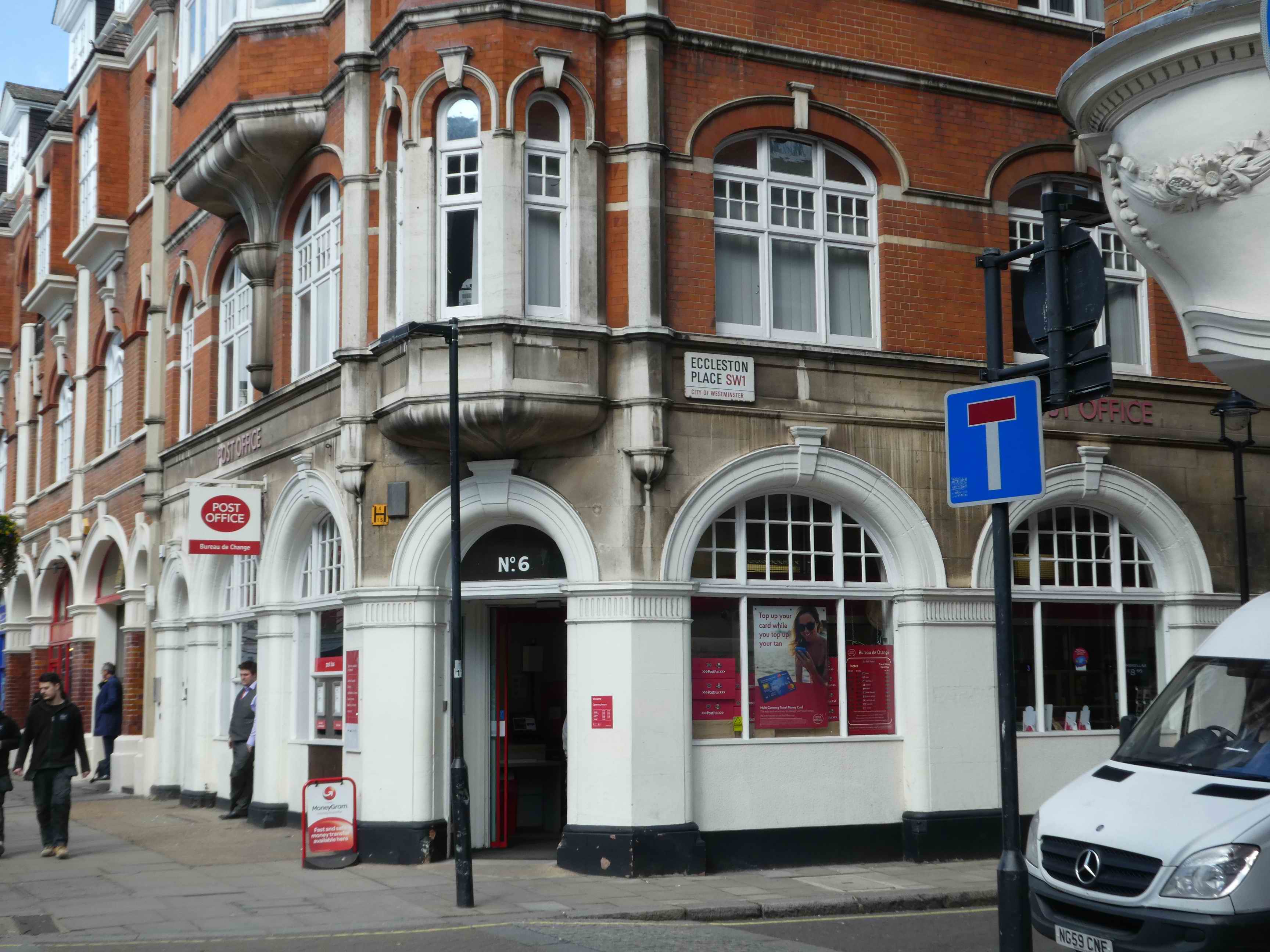
It’s not widely known, but there are still about 1,500 gas lamps operating in London. The lamps burn a tiny pilot light continuously, but at dusk the timers fitted move a lever, which opens a valve to open the gas supply, which lights up the mantles. Although they do not need lighting every night, the timers need adjusting every fortnight to allow for changing daylight hours. In addition the mechanisms need to be wound and checked, the glass polished and the mantles replaced. This is the work of a team of five engineers from British Gas.
Survival of the gas lamps is also a tribute to English Heritage, which has protected and restored them. When a lorry drives into
a lamp it is re-cast and replaced just as it was. The gas lights glow with a soft parchment coloured light, as distinct from the
harsh white light generated by the electric fittings that have replaced them.
Some of the gas lights are approaching 200 years old as can often be seen from the royal cipher, the earliest one of which is
“GR IV” from George 4th, king from 1820 – 1830. The most recent lamps were installed near to the Queen Mother statue which was
dedicated in 2009.
This 7 km walk around central London starts at the post office in Eccleston Place SW1, near to Victoria Station. As well as
visiting many familiar tourist sites, the walk highlights a wide variety of gas lamps.
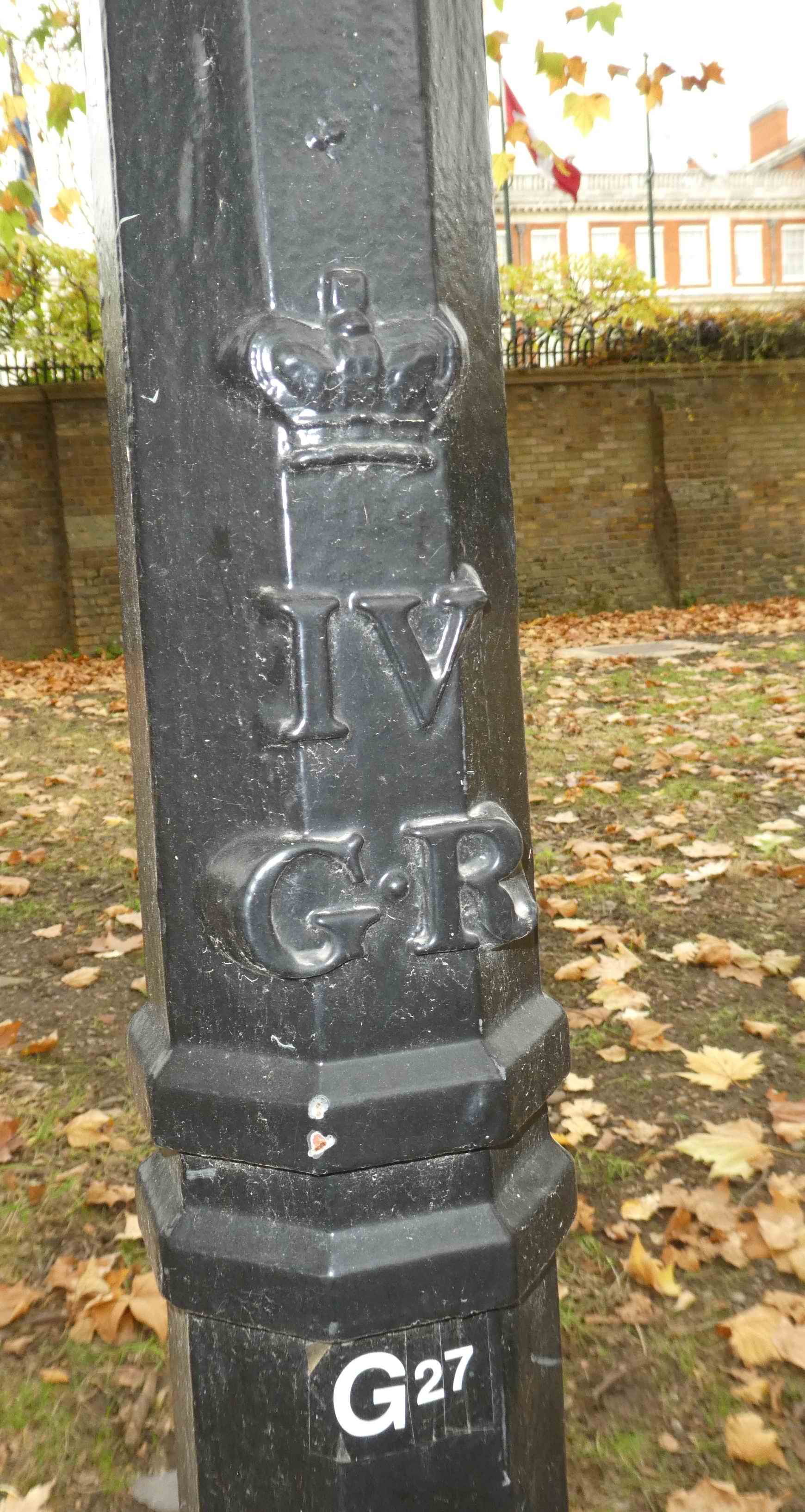
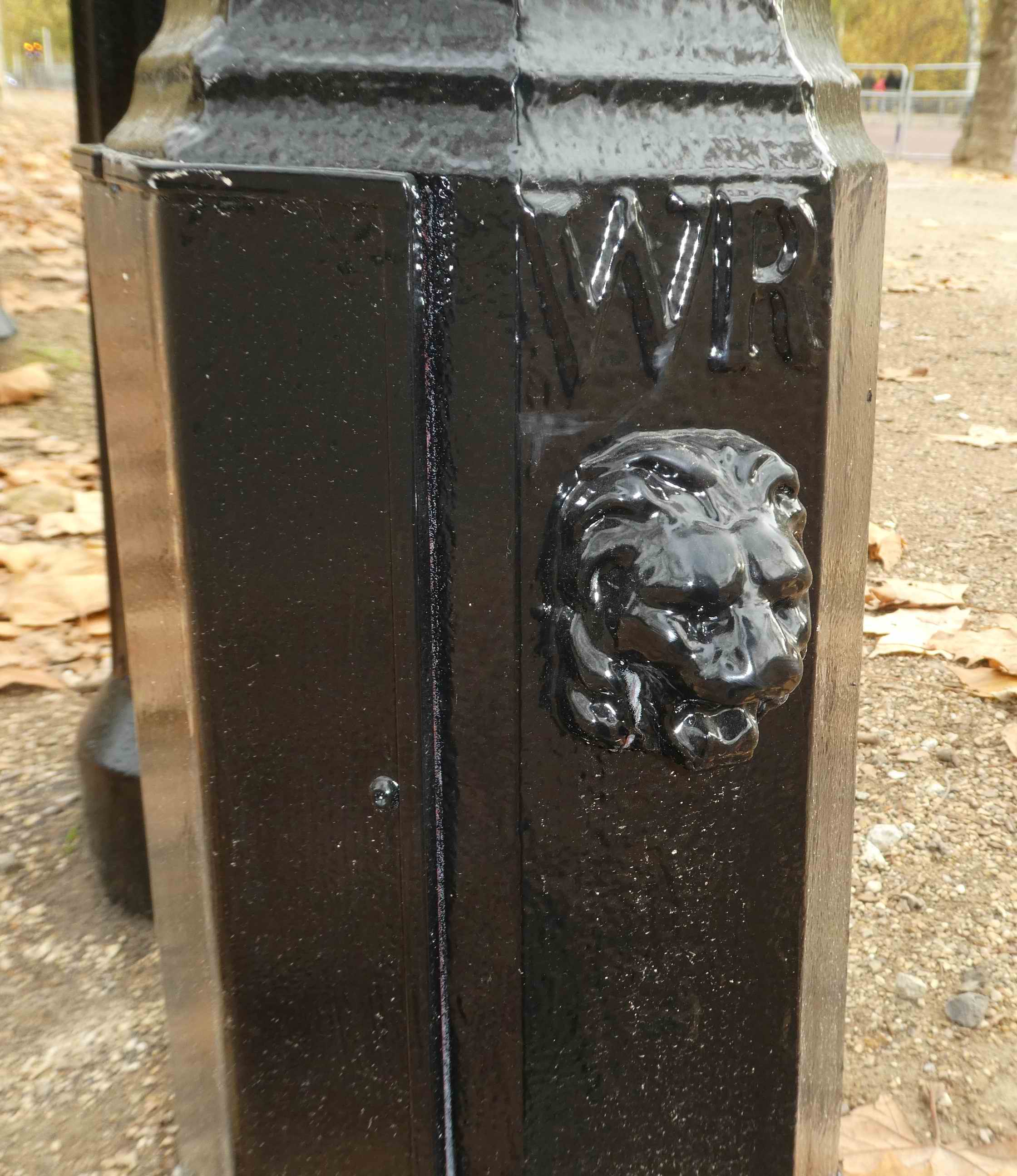
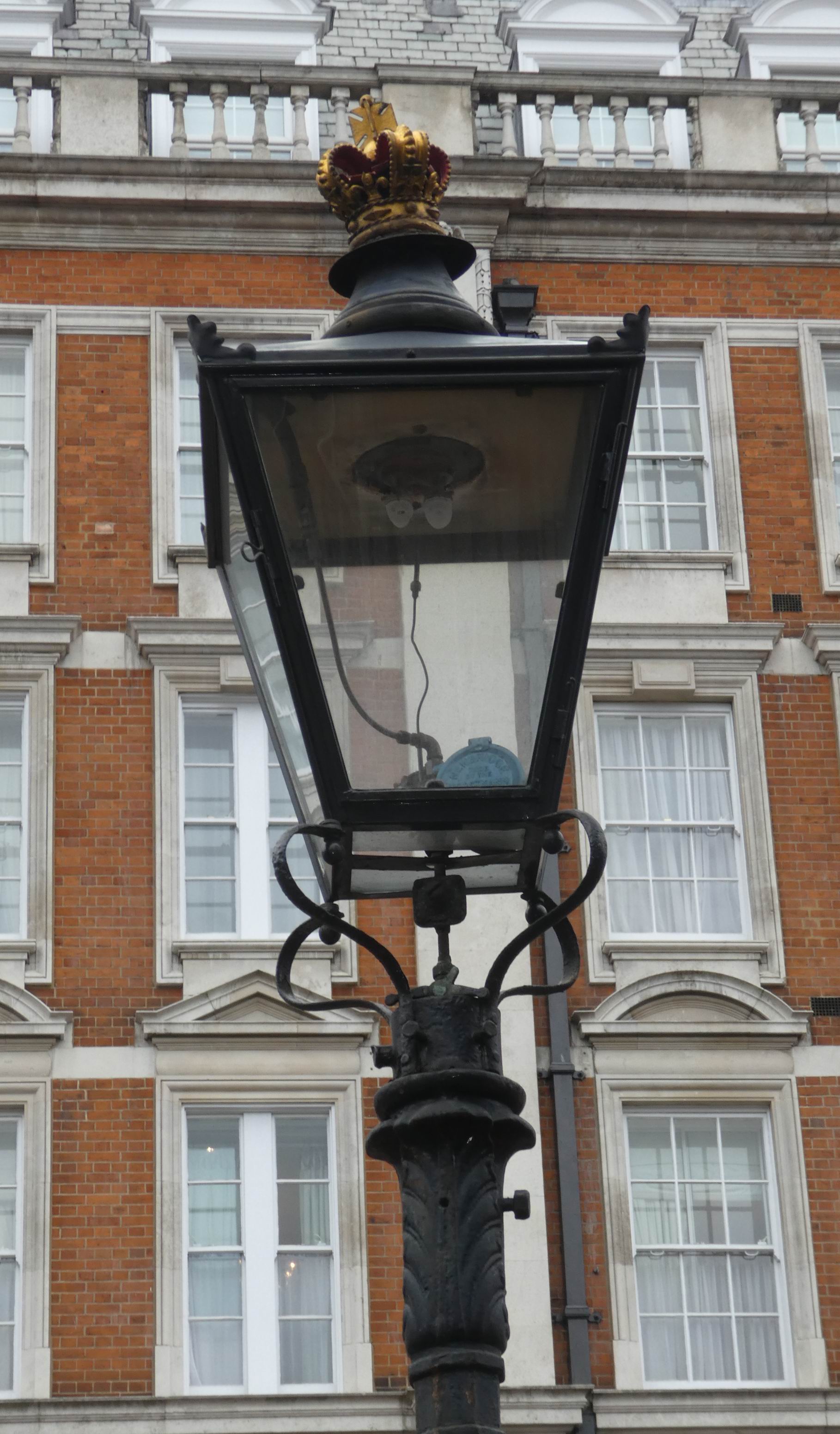
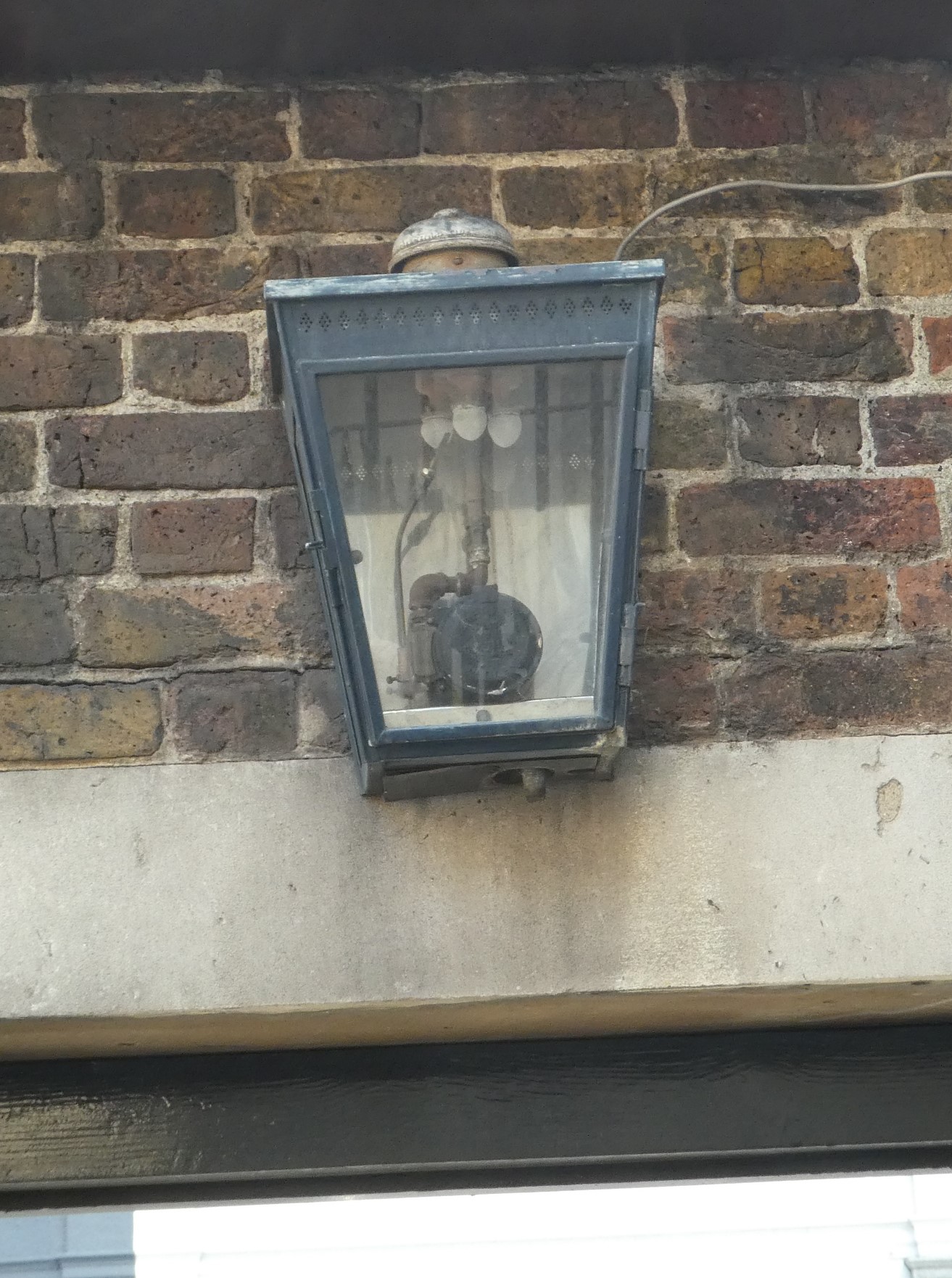
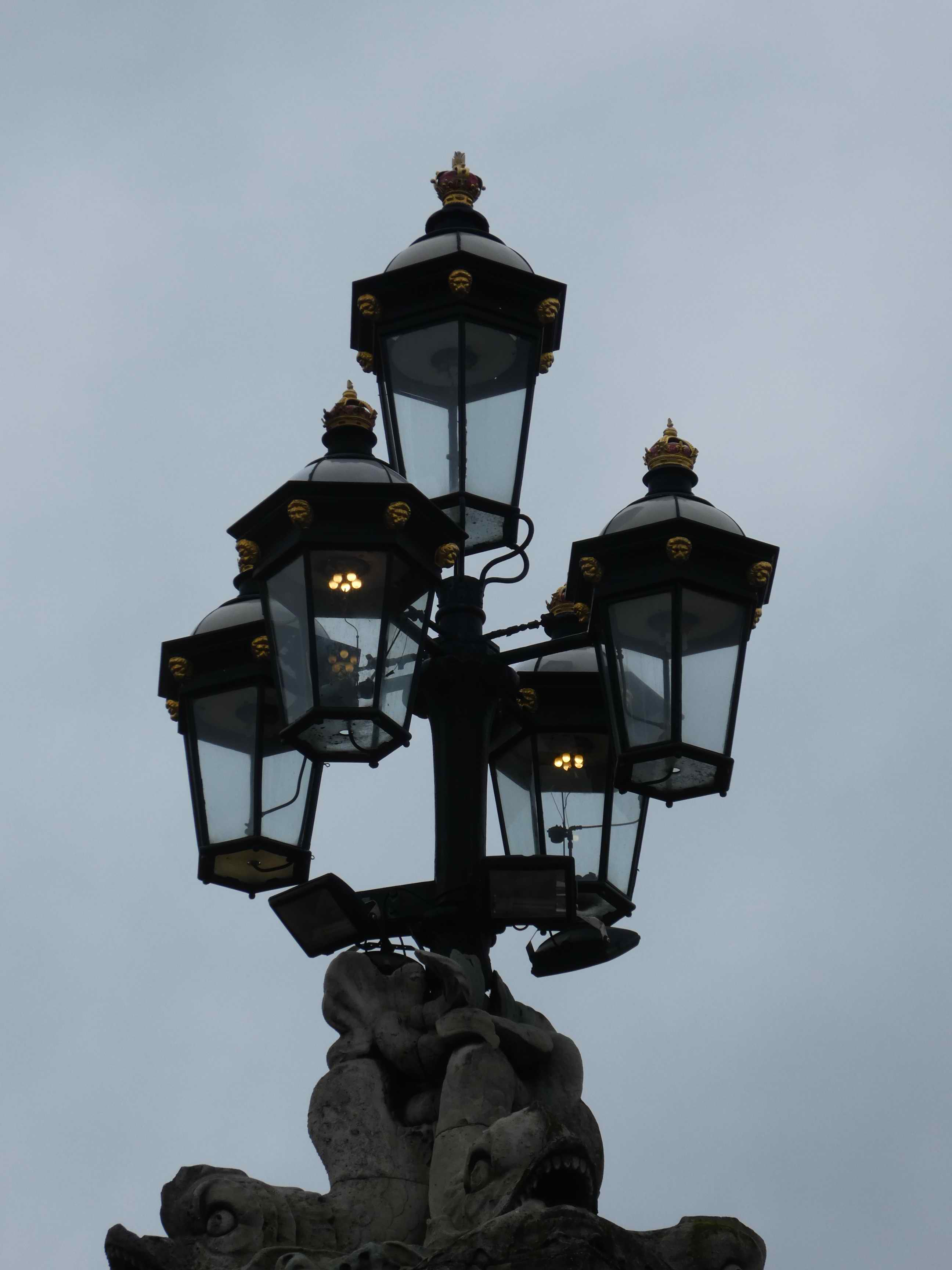
From the post office, cross Eccleston Place and walk along Ecclestan Street to the next junction, where you turn left along Buckingham Palace Road. Continue along the left side, crossing several roads. You reach the “Bag O’ Nails” pub, where you cross Lower Grosvenor Place. Continue a few yards to the gated entrance to Buckingham Place Mews, opposite the Rubens Hotel. Each side of the gates, on the Buckingham Palace Road kerbside are our first gas lights.
These lights have rather special gold tops and are each side of the gated entrance to Buckingham Palace Mews, opposite Rubens Hotel.
A little further along Buckingham Palace Road a less elegant gas lamp is visible just inside the public entrance to The Royal Mews, above the gateway.
Continue along the side of the palace grounds, the road becomes Buckingham Gate. Look out for numerous gas lights visible in the areas of the palace without public access as well as on the gateposts. Walk round to the, usually crowded, front of the palace.
Attractive gold and black gas lamps adorn the security gated entrances on the roadway to the area, and there are lamps on the palace gateposts and on the palace walls. The main palace entrances are surmounted by very impressive fittings each comprising five lamps.
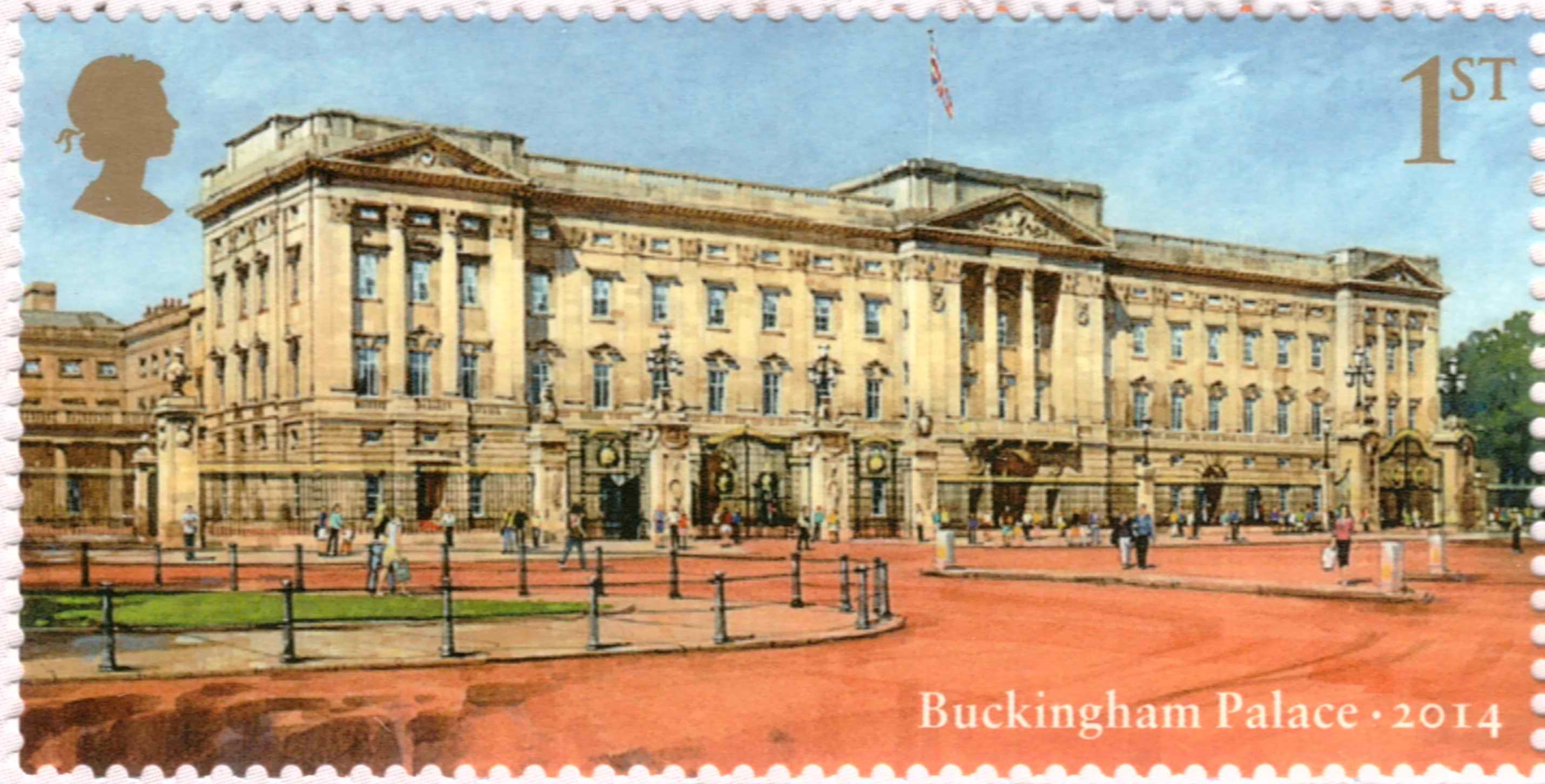
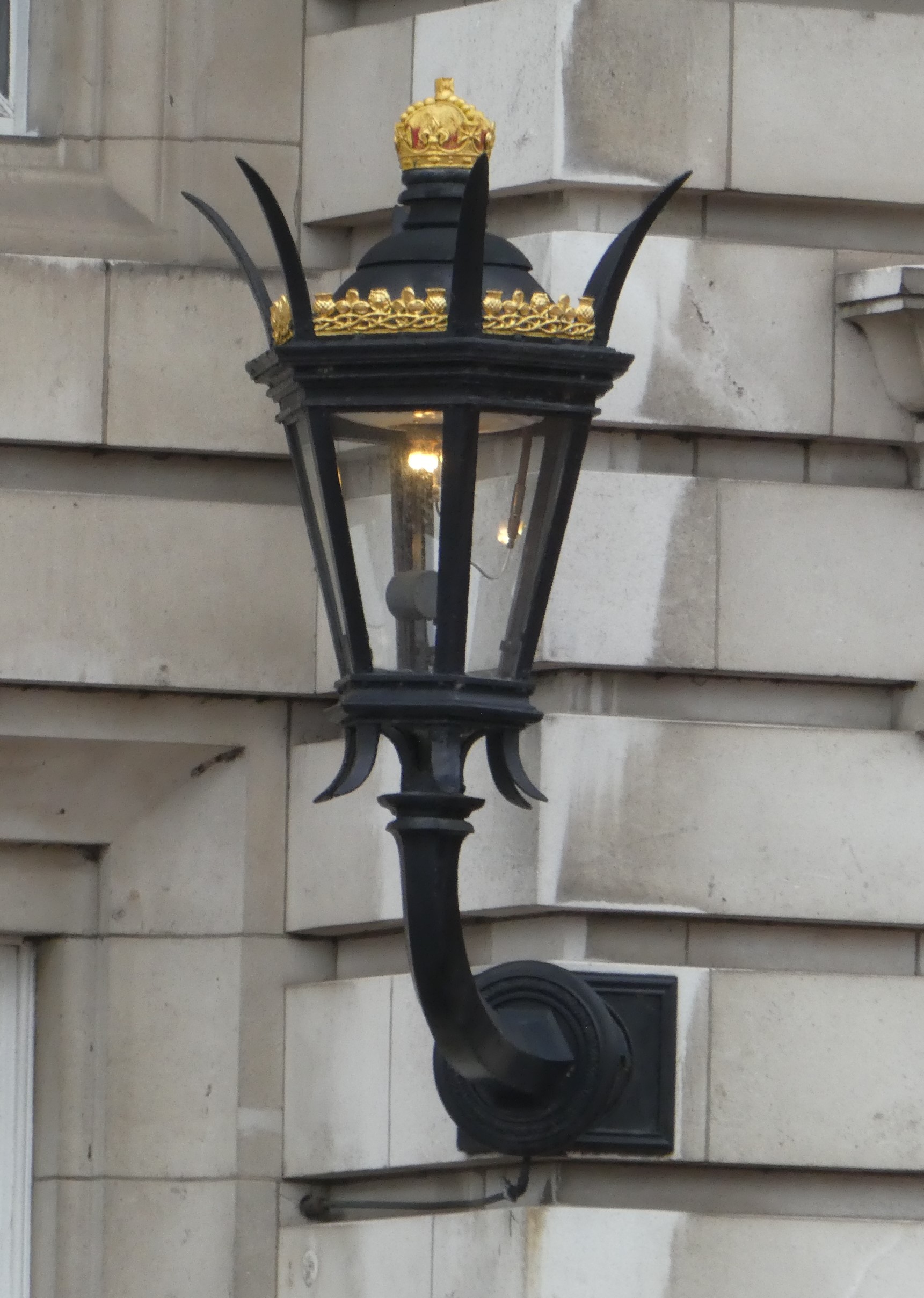
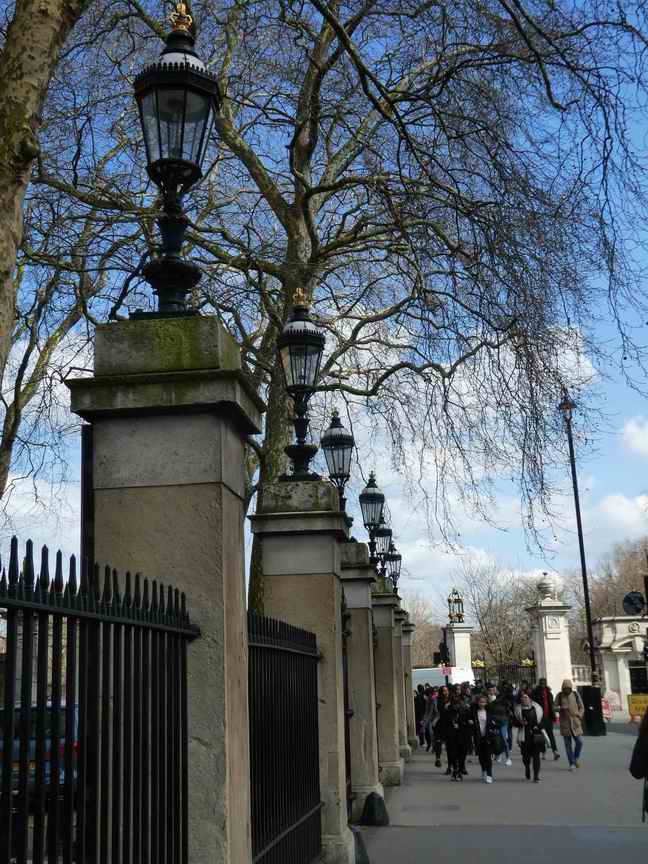
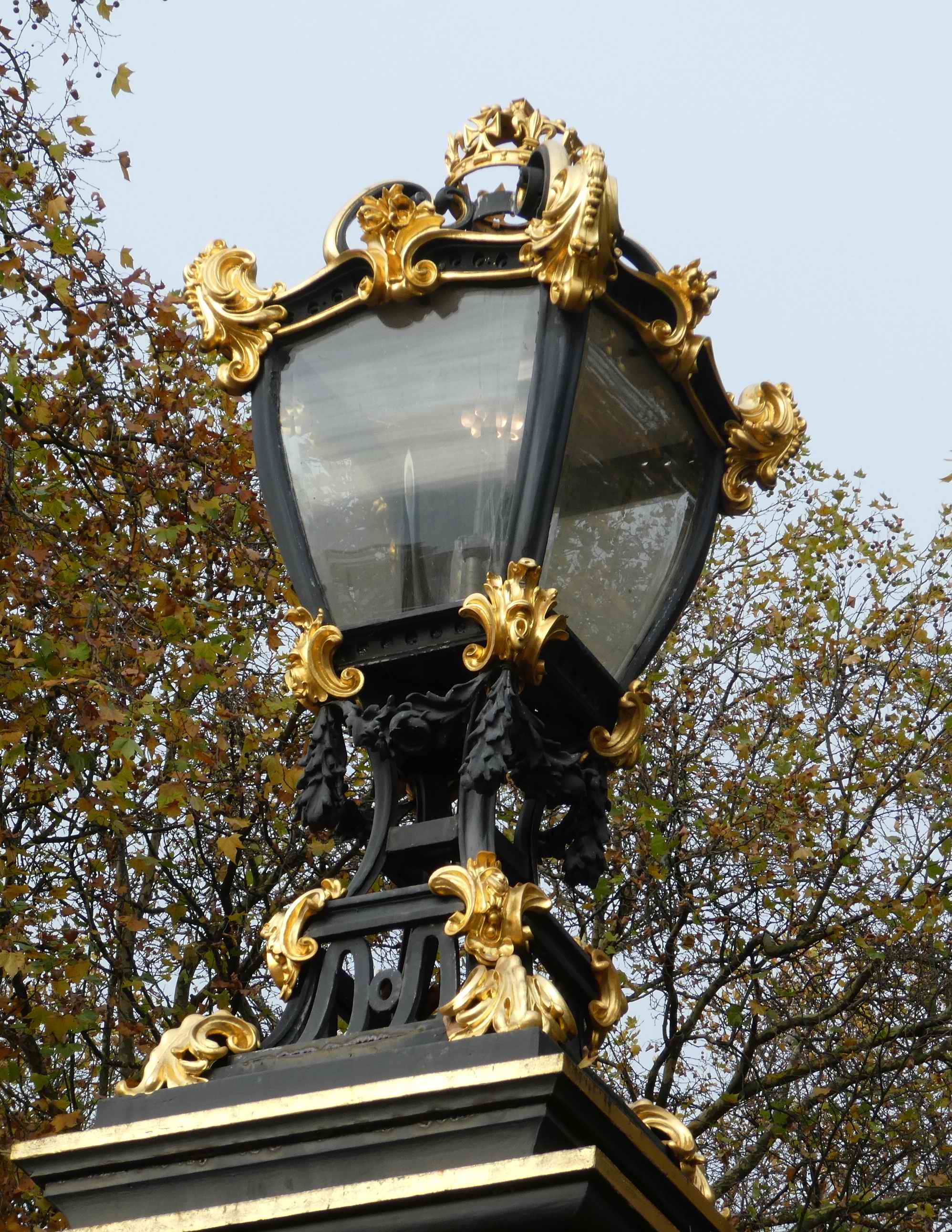
This path goes through Green Park. All along the left side are gas lights. But look to your right: the first building you can see is Lancaster House, site of The London Economic Summit Conference, shown on the 31p stamp in 1984. A better view of the building does not appear available, since there is significant security in this area, perhaps explained as the building next to Lancaster House is Clarence House, official residence of the Prince of Wales.
If you want to explore this area further, you can continue along the path until you reach a small iron gate on the right, at the end of the low railings, immediately before the railings become much higher. Go through the gate (gas light to your right) and up the steps. The path leads though to the gas lit, Cleveland Row. Note security around the entrance to Stable Yard, this being the way to Clarence House.
When ready, return to the Mall, the way you came, and turn to the left.
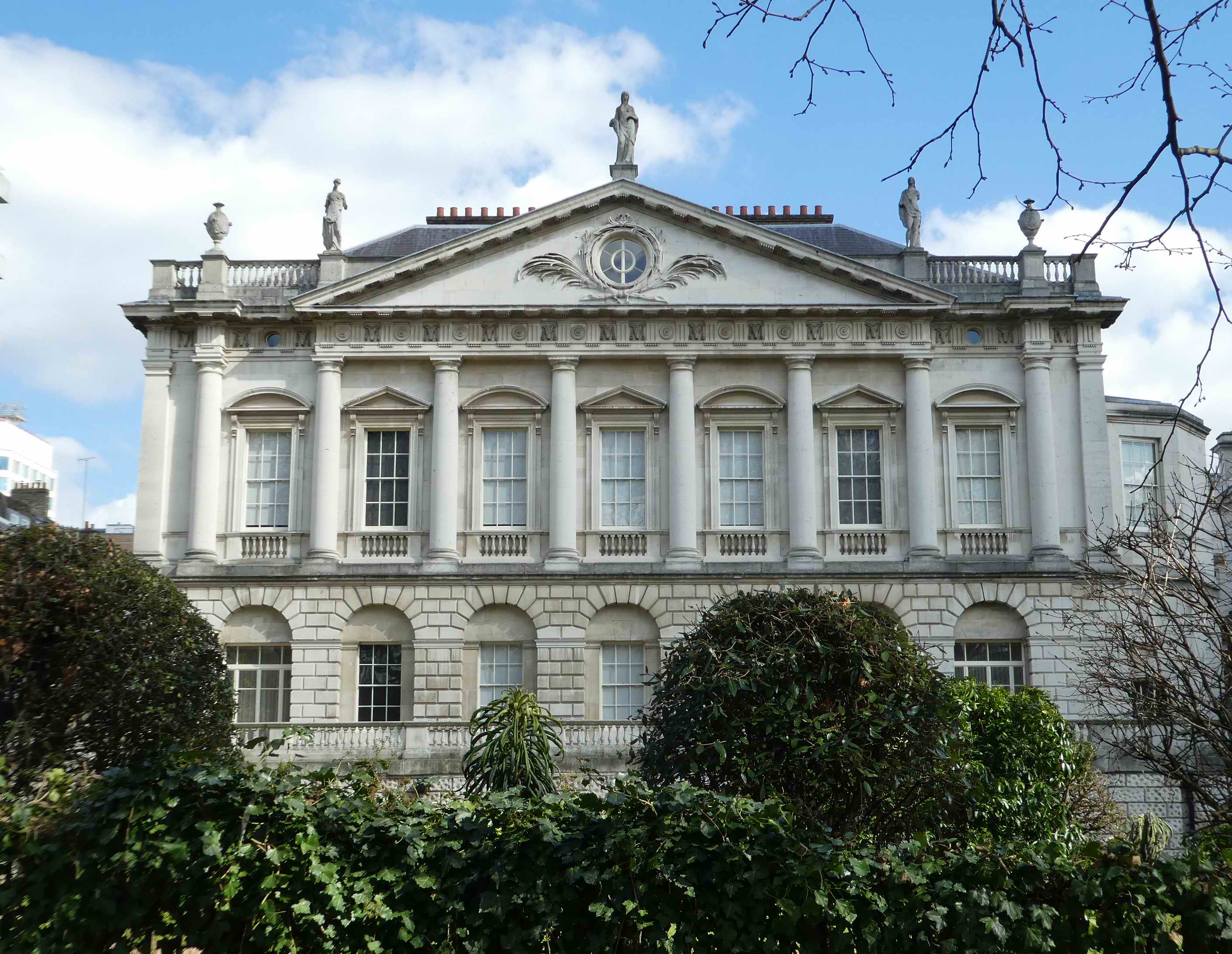
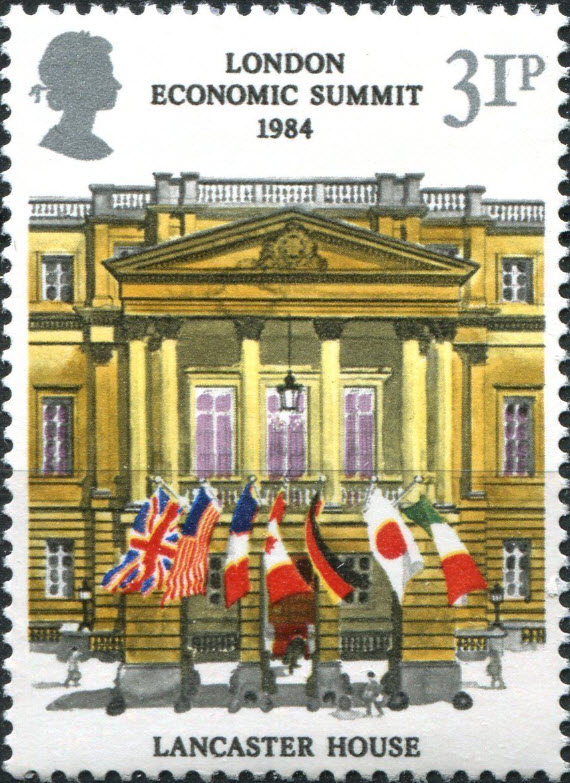
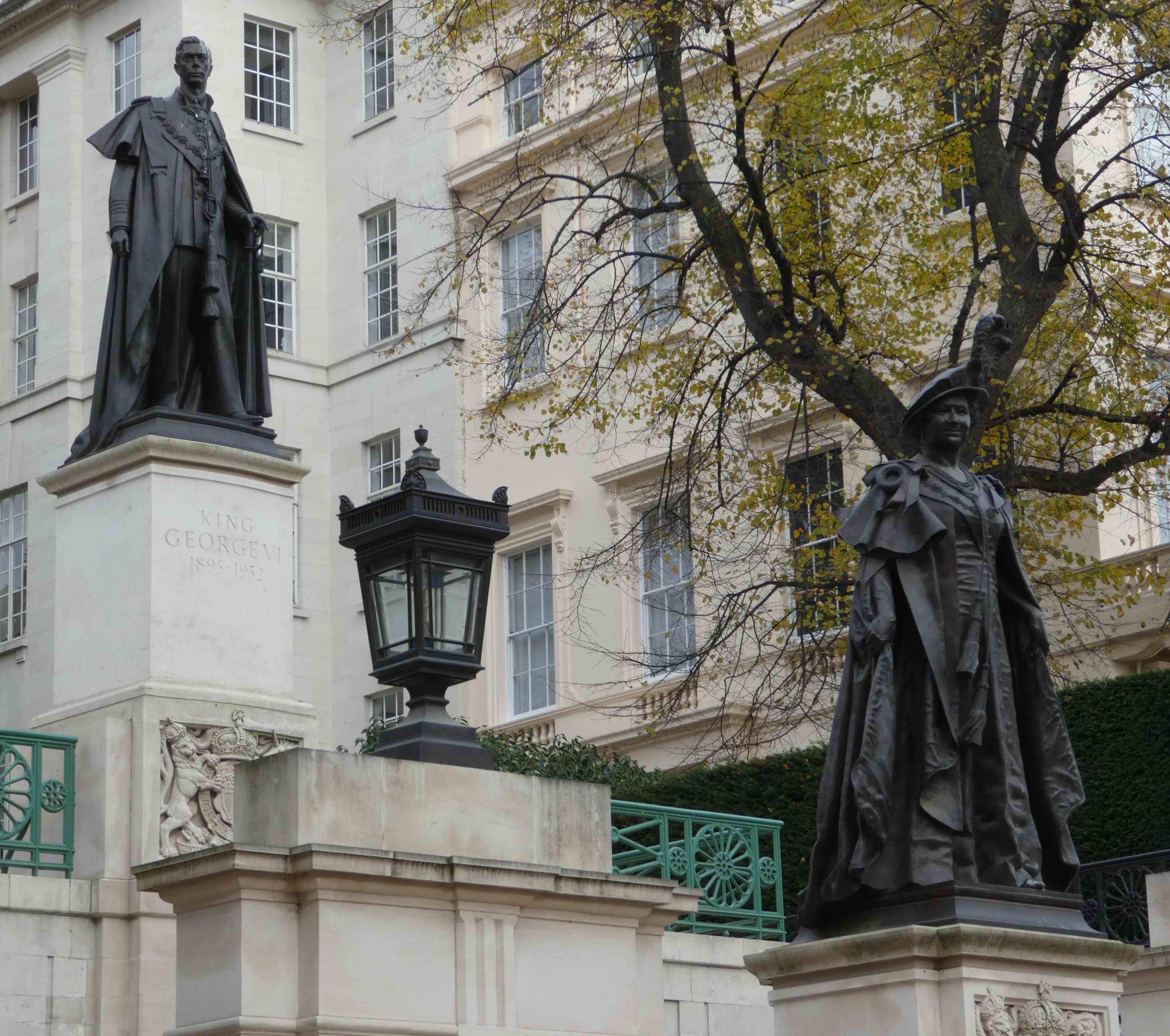
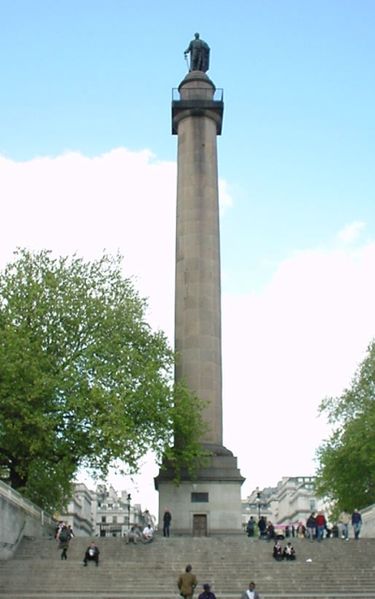
Walk about 550m along The Mall to the King George VI and Queen Elizabeth Memorial.
Note the modern gas lights here. The memorial to the Queen Mother, who died in 2002 aged 101, was unveiled by HM The Queen in 2009. The Royal family specified that gas lights were to be used. The memorial cost £2M, and was funded by the issue of a £5 coin produced by the Royal Mint to celebrate the Queens 80th birthday. This must have been a better finance option, if you were in the army, than that adopted in 1827, see below.
Continue another 200m along The Mall to the Duke of York Column. Turn left, noting the gas lights either side at base of the steps, and walk up to the 38m high column.
When the Duke of York died in 1827 the entire British Army lost one day’s wages to pay for the monument, which was completed in 1834. The Duke of York was the second son of King George III, and he was probably the subject of the nursery rhyme. He was commander–in-Chief of the British Army during the French Revolutionary Wars and the Napoleonic Wars. His one field command of significance was the Flanders Campaign of 1793–4, which resulted in the heavy defeat at the Battle of Tourcoing (1794), followed by his recall to England. Flanders having something of a reputation for being flat, the specific location of the "hill" in the nursery rhyme has been hypothesized to be the town of Cassel which is built on a hill which rises 176 metres (about 570 feet) above the otherwise flat lands of Flanders in northern France.
Just past the column you come to Carlton House Terrace, explore both left and right as there are very old gas lamps on each side. When you’ve seen enough proceed along Waterloo Place, going away from the column.
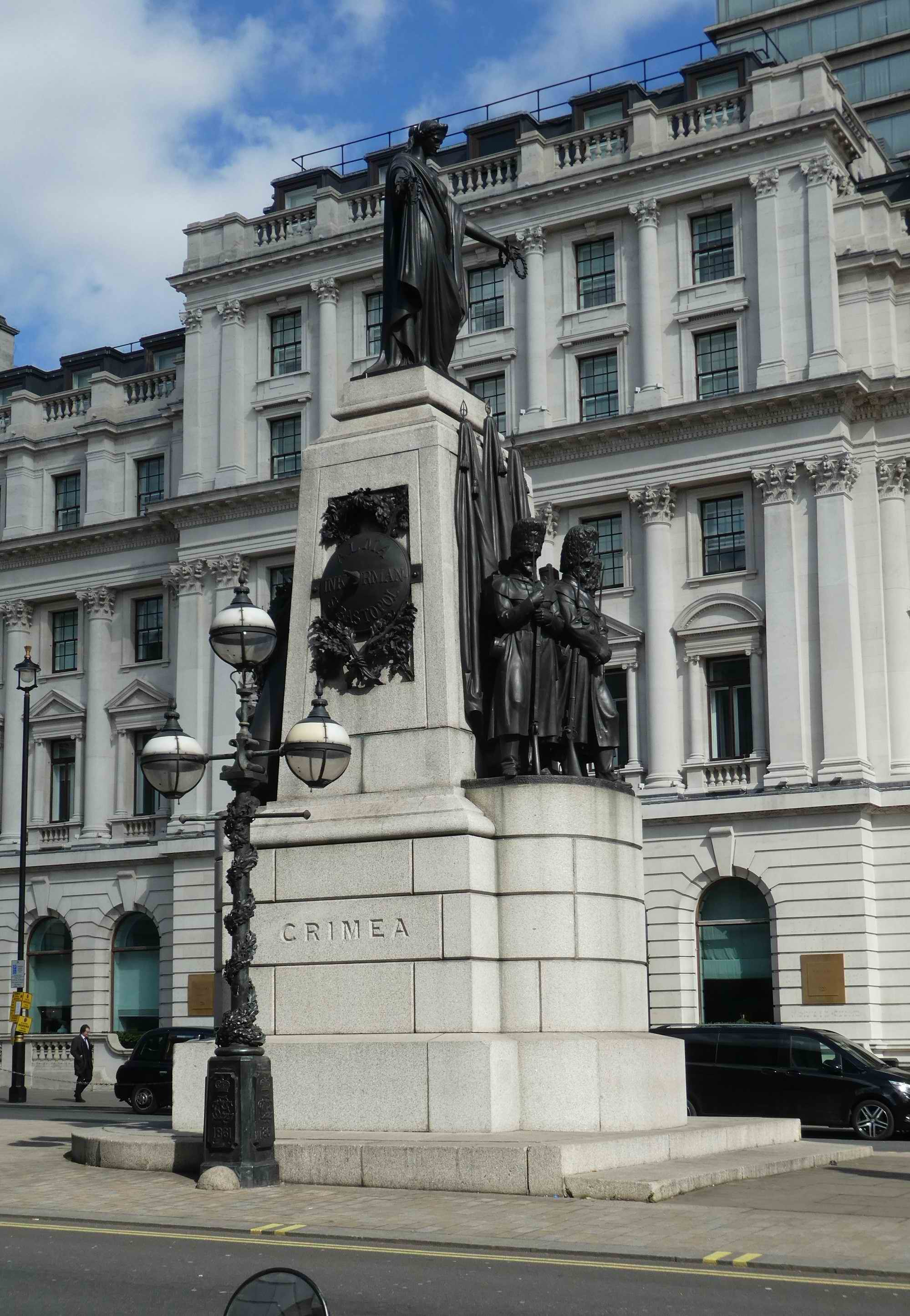
Turn left from Waterloo Place, along Pall Mall. Cross Carlton Gardens and continue to the end of the next building, 100 Pall Mall, now serviced office accommodation.
This is where in Pall Mall, the first use of gas street lighting in the world was demonstrated, by Frederick Winsor in June 1807. Winsor, originally Friedrich Albrecht Winer, was a German inventor, who became one of the pioneers of gas lighting in Britain. He founded the Gas Light and Coke Company, which grew to eventually be the basis of the North Thames Gas Board, but he returned to France to establish a, less successful, company in Paris, where he died in 1830. A green plaque here by the Institution of Gas Engineers and Managers commemorates the demonstration.
Retrace your steps and continue along Pall Mall. After about 400m you reach Trafalgar Square. Proceed along the North Side, by the National Gallery.
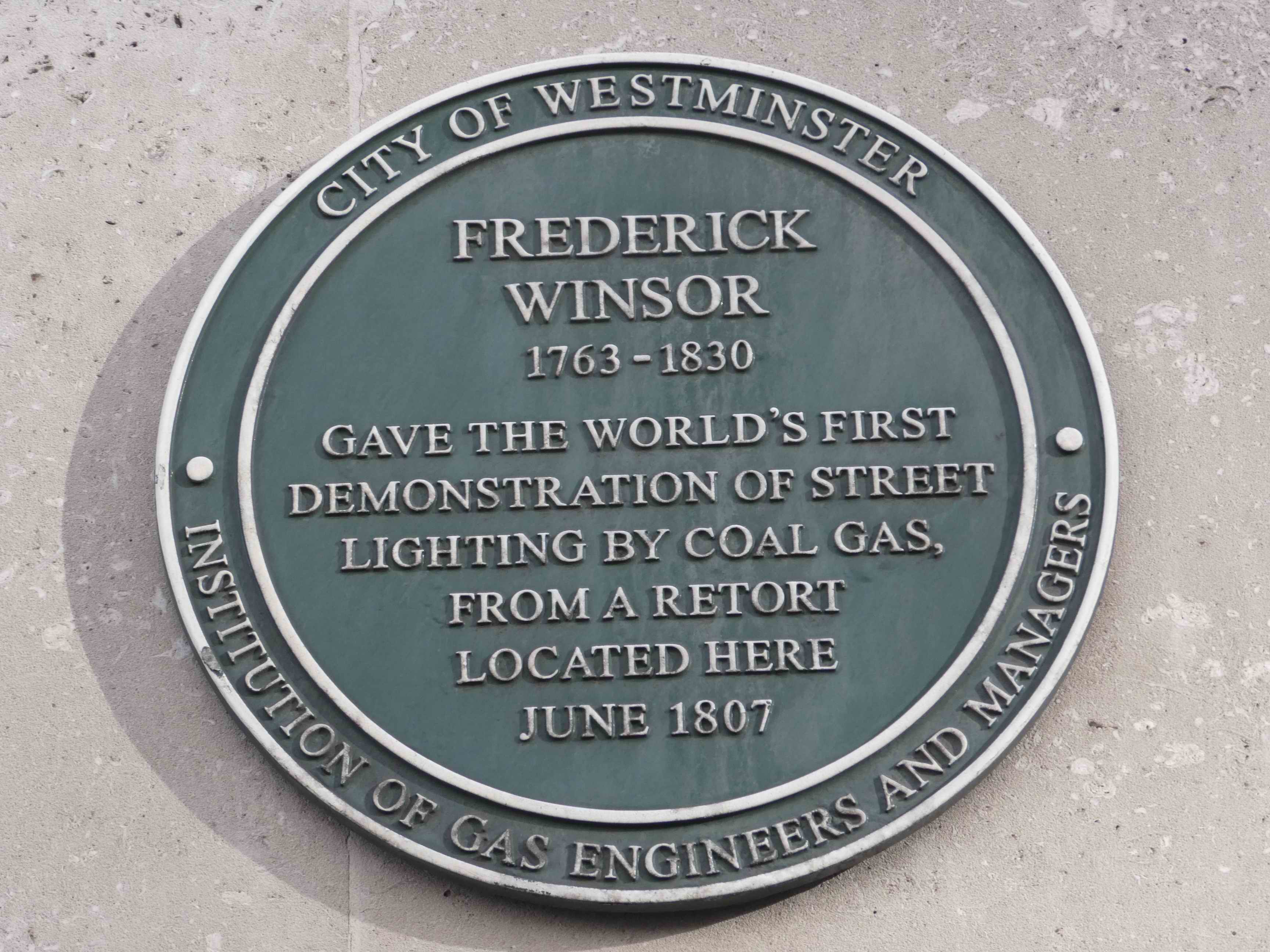
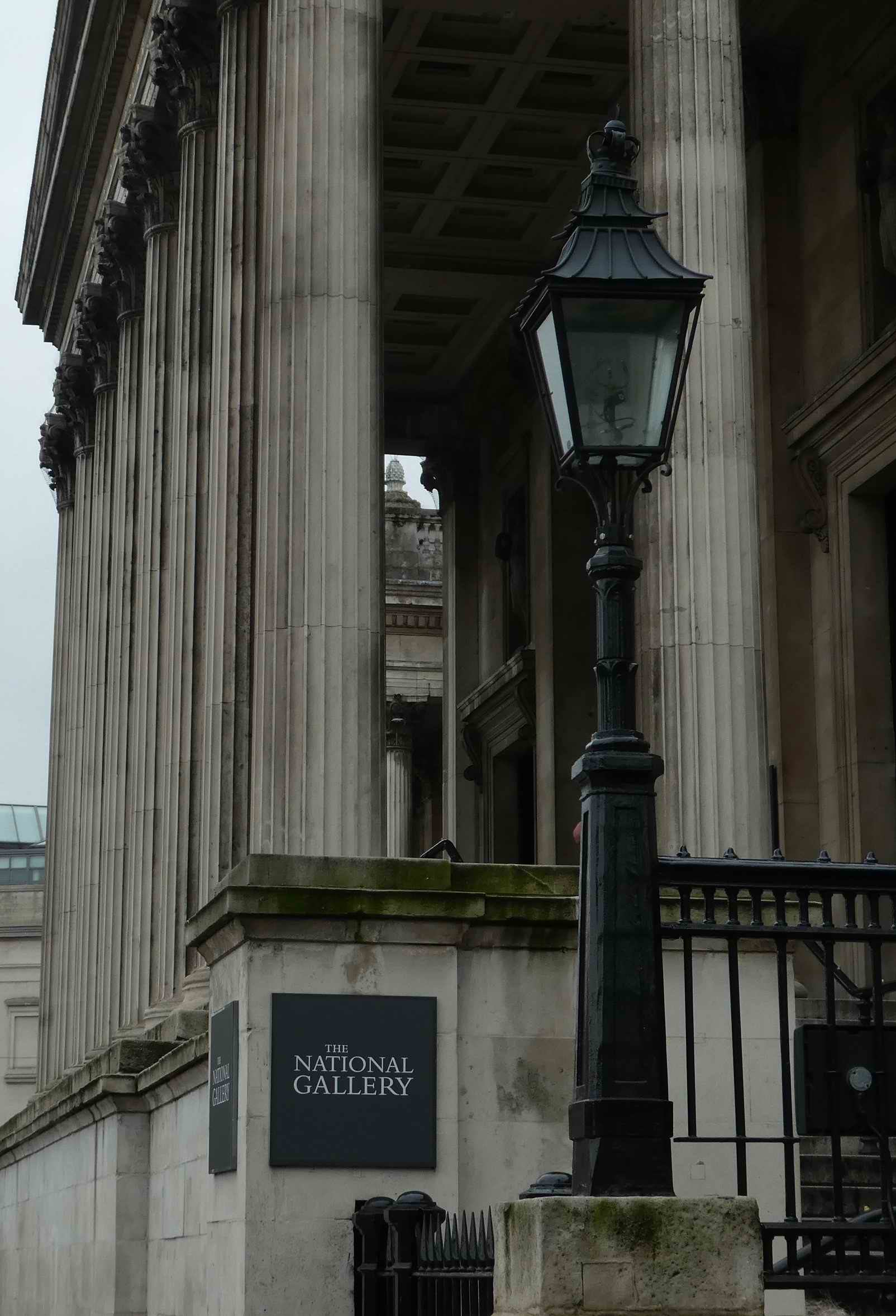
Turn left out of Trafalgar Square, and cross St Martin’s Place to the Edith Cavell Memorial, after St Martin in the Fields church.
Should you be in need of refreshment at this point, the "Moon Under Water" is about 3 minutes (250m) walk away. Proceed north along Charing Cross Road, to Irving Street, the next turning on the left. Follow Irving Street into the pedestrianised section and turn right in Leicester Square to your destination.
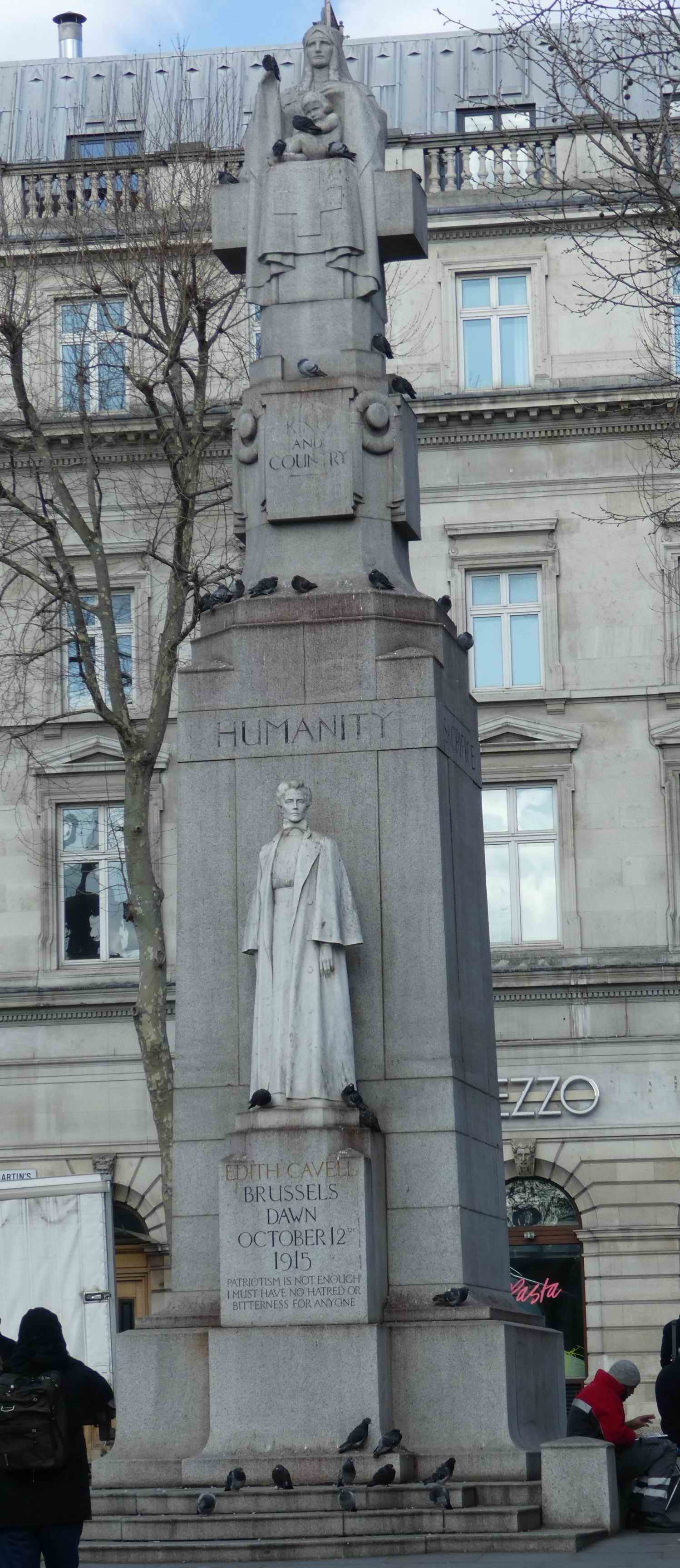
Edith Cavell was a British nurse from Norfolk. She was matron at Berkendael Medical Institute in Brussels when the First World
War broke out in 1914. In addition to nursing soldiers from both sides, she assisted some 200 Allied soldiers escape from
German-occupied Belgium. She was arrested in August 1915, court-martialled, found guilty of treason, and shot by a German
firing squad on 12 October 1915. Her story was used in British propaganda as an example of German barbarism and moral depravity.
Although Cavell's sister, Lilian Wainwright suggested no monuments should be erected, funds for a public memorial were raised
by a committee chaired by Viscount Burnham, owner of the Daily Telegraph, together with the Lord Mayor of London, the Bishop
of London, and the chairman of London County Council. Sculptor Sir George Frampton accepted the commission in 1915, but
declined any fee.
William IV Street is just beyond the Cavell memorial. The Trafalgar Square post office further along William IV Street used
to be famed as it was then open 24 hours per day, and was crowded on the nights of new stamp issues, when collectors wanted
to be amongst the first to acquire them.
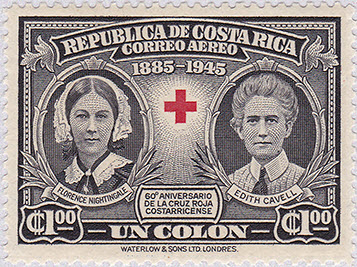
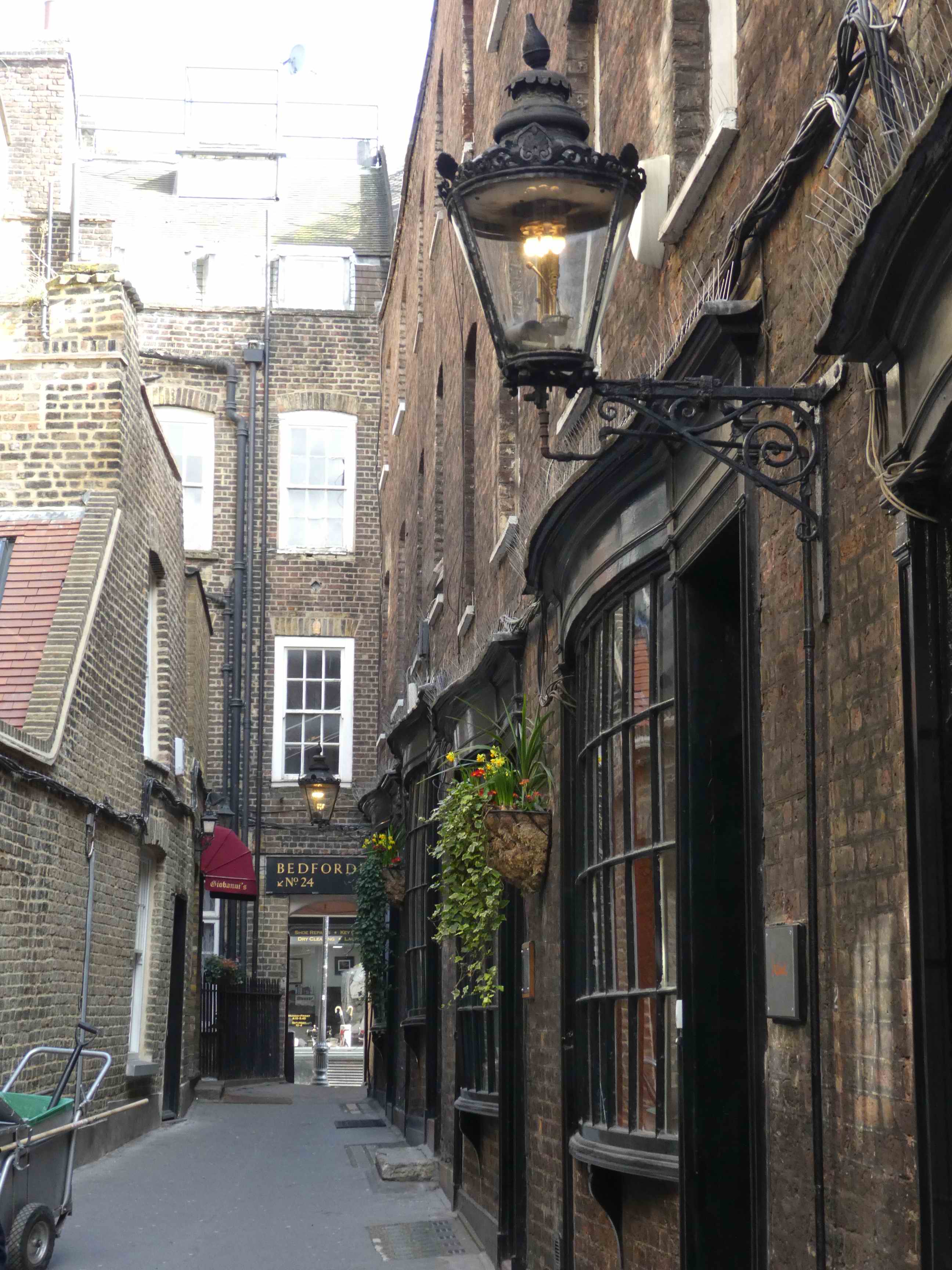
The attractive Goodwin’s Court has gas lighting but is more famed as the inspiration for Diagon Alley in Harry Potter.
Walk through Goodwin’s Court and turn left at the end into Bedfordbury, then almost immediately right into New Row. Spot the gas light on right opposite “The Round House”. At the junction with Garrick Street cross over into King Street, this has modern gas lights.
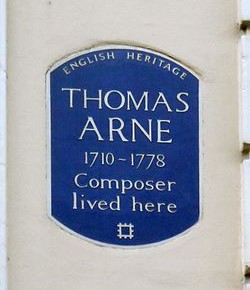
At the end of King Street you are at Covent Garden Piazza. Turn right to St Paul’s Church, and right again into the garden.
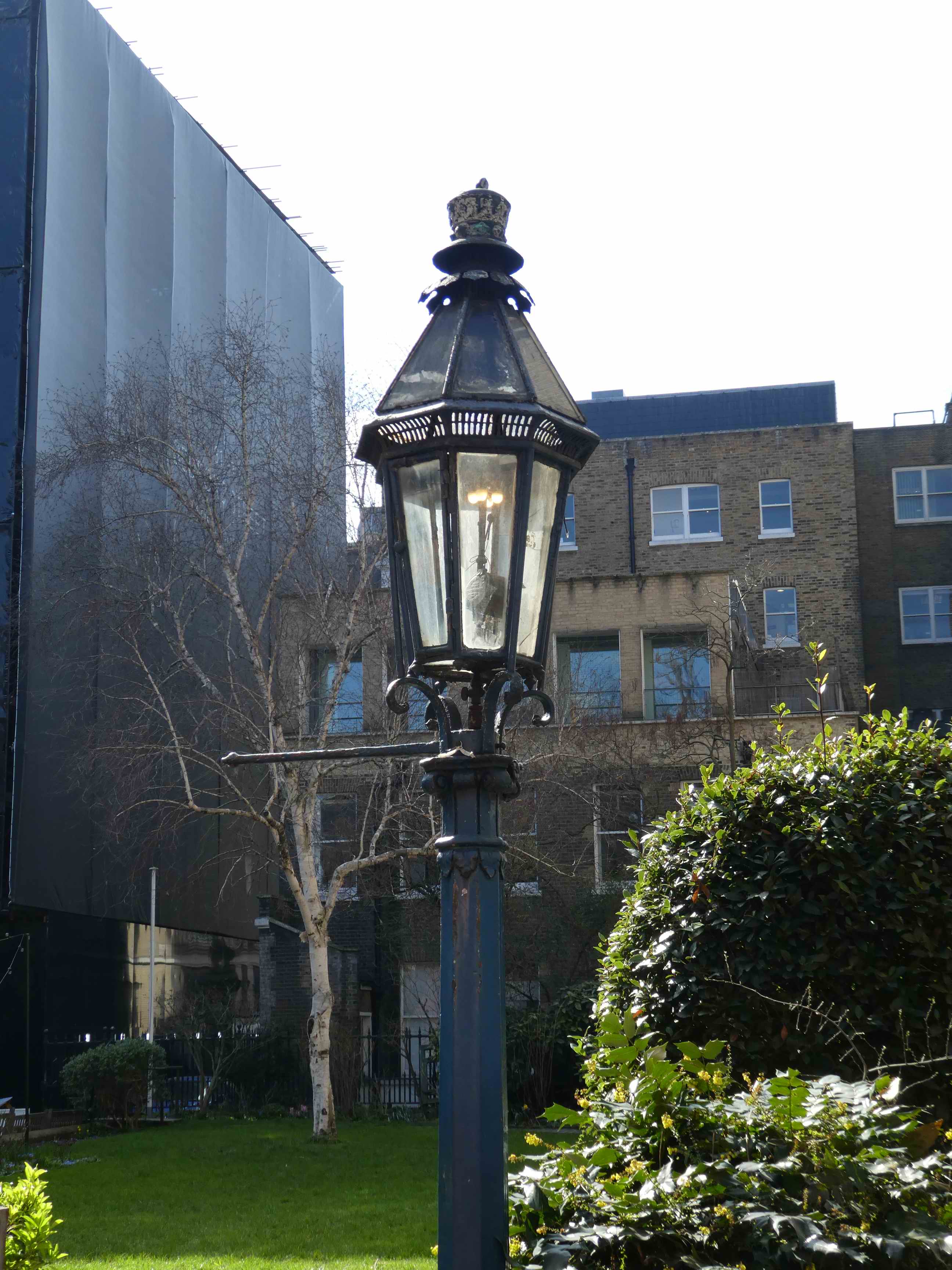
There are many blue painted gas lamps, although some are in need of restoration. The church, known as the actors church through its long association with the theatre community, was designed by Inigo Jones. It is recognisable from the stamp issued in 1973 for the 400th anniversary of his birth, although it has been substantially altered and restored since its completion in 1633. Originally there were six or seven steps leading up to the portico, but these disappeared as the level of the Piazza was raised over the years. Samuel Pepys noted in his diary on May 9th, 1662, the first "Italian puppet play" under the portico — the first recorded performance of "Punch and Judy", a fact commemorated by the annual MayFayre service in May, and a plaque outside the church. The artist J. M. W. Turner and dramatist Sir William S. Gilbert (of Gilbert and Sullivan fame) were both baptised at St Paul's.
For the rest of the walk, please click here
